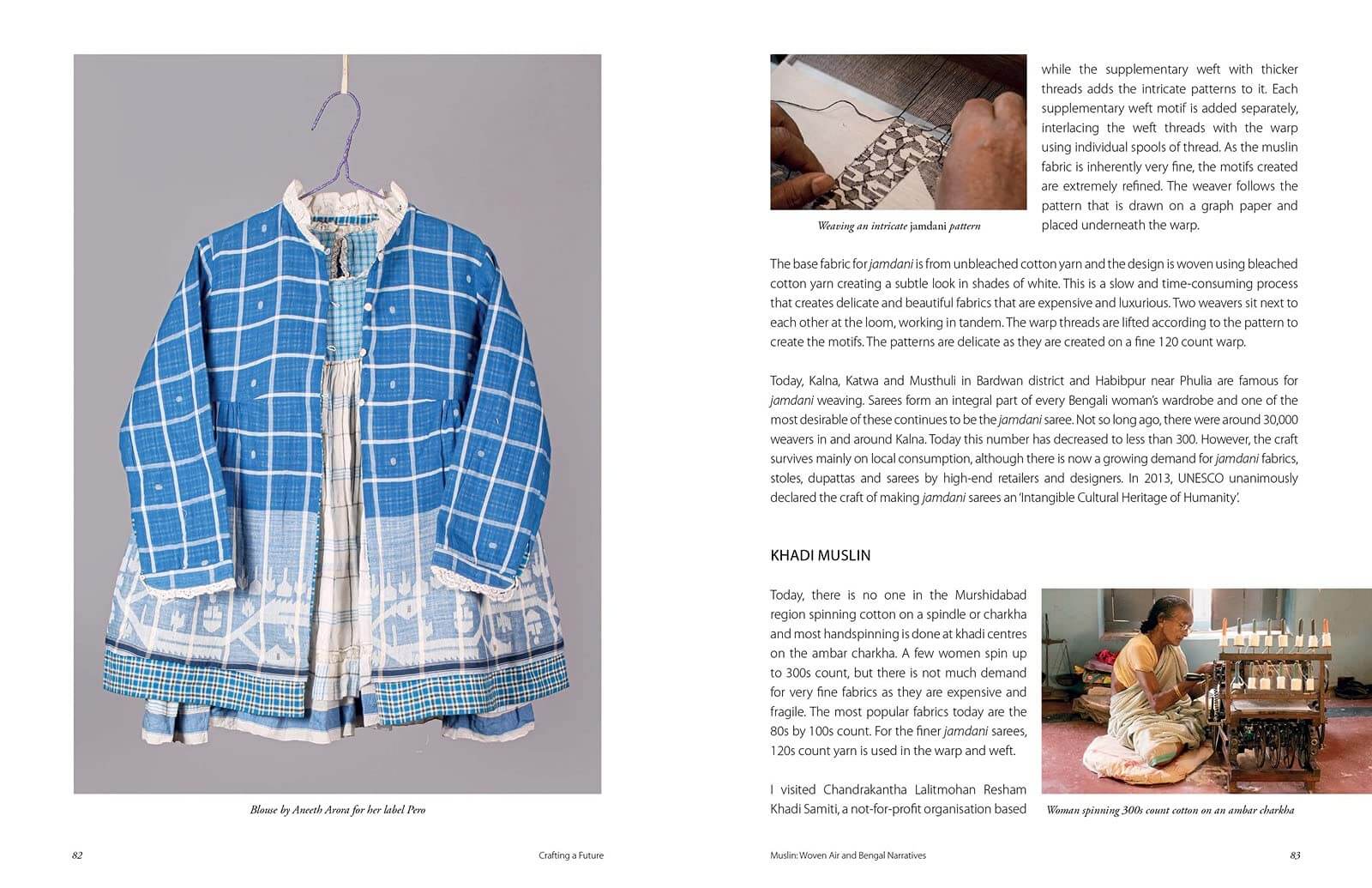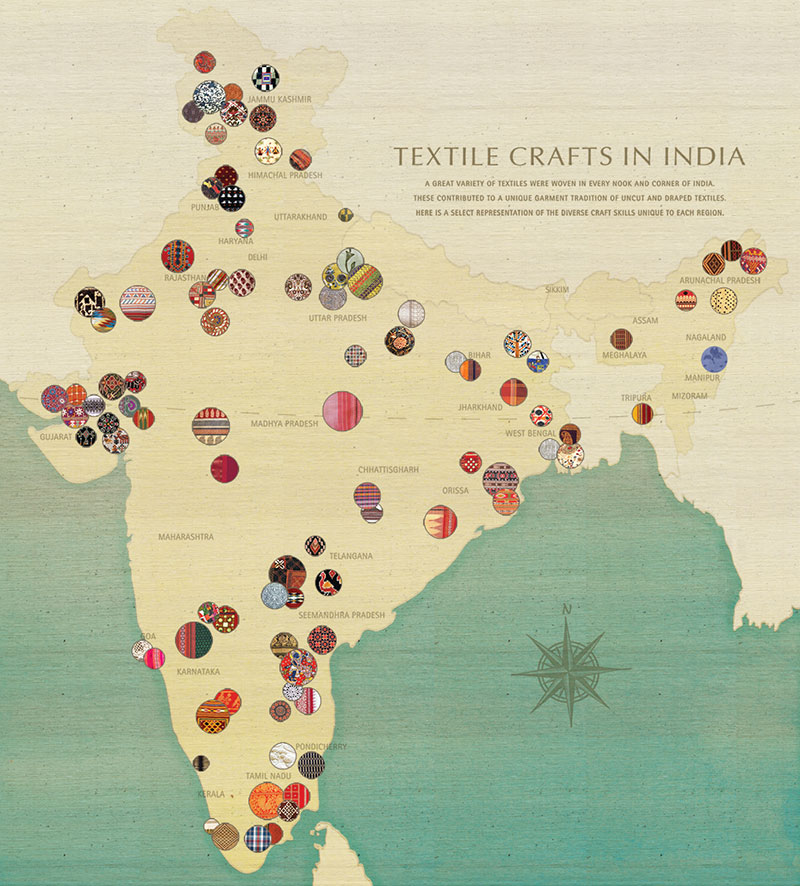Crafting a Future – Stories of Indian Textiles & Sustainable Practices by Archana Shah

Crafting a future by Archana Shah pays homage to the rich heritage of handcrafted Indian textiles through inspiring stories of artisans, designers and NGOs, across the geography of India, ranging from cotton to silk.
In her foreword, Laila Tyabji, describes Crafting a Future as a scholarly & a riveting travelogue, quite different from a usual coffee-table book. She advices readers not to see the book as an elegy but as a roadmap, a guide to view handloom not as a part of the past but as a central part of the future.
The book is an outcome of Archana’s conversations with the craftspersons, broadly divided into three sections that deal with natural fibres: cotton – a plant based fibre; silk – produced by insects; and wool – obtained from animals.
Each section, first presents the story of the particular fibre in indian context, across the history. The author carefully follows the growth of related, matched with historical events, highlighting the impact on artisanal production. The story on each of these natural fibres is followed by chapters covering peculiar aspects like fabrics, dyes, crafts & techniques associated these fibres.
About the Book:
| Title | Crafting a Future – Stories of Indian Textiles & Sustainable Practices |
| Author | Archana Shah |
| Pages | 276 pages with 375 colour photographs |
| Publisher | Niyogi Books |
| Sample | Read Now |
| Available at: | Buy from Amazon |

List of Chapters:
- Foreword by Laila Tyabji
- Introduction
- THE STORY OF COTTON
- KHADI: The Fabric of Freedom
- WARDHA: Gandhiji’s Legacy and Vision
- CHARAKA: The Road to Economic Independence
- MALKHA: Redefining Khadi
- PONDURU: Continuing the Tradition of Handspinning
- MUSLIN: Woven Air and Bengal Narratives
- KALA: Indigenous Organic Cotton from Kutch
- INDIGO: The Coveted Natural Dye
- THE STORY OF SILK
- TASSAR and Other Textiles of Odisha
- ERICULTURE: Enriching Lives in the Northeast
- MULBERRY cultivation: Creating Jobs in Karnataka
- RAJKOT PATOLAS: Learning New Skills
- BENARES BROCADES: Changing Trends
- The STORY OF WOOL
- PASHMINA: Wool from the Mountains
- UTTARAKHAND: The Nomads and Other Stories
- KUTCH: The Revival of Desi Wool
- The FUTURE OF FASHION
- Afterword
- Appendix I: SPINNING and WEAVING
- Appendix II: TEXTILE CRAFTS OF INDIA
Author:
Archana Shah
Archana Shah’s journey through handmade textiles began in 1977, when as part of her student project she visited Damadka village to study Block Printing.
She was completely fascinated by the resist-dye technique of Bandhani and started Bandhej in 1985 with a vision of upholding, preserving & sustaining the skills and & indigenous knowledge of artisans.
In the course of 40 years, she has been collaborating with a large network of artisans around the country.
In 2013, Archana published her first book, SHIFTING SANDS – Kutch Textiles, Traditions Transformation. It recounts her personal journey of discovery, which is interwoven with her association of over four decades with the land of Kutch, its people and their crafts.
She continues to believe that there is a lot to learn from traditional wisdom and continues to live with her family and dogs in Ahmedabad.

Between the Lines
Along with regularly highlighting the negative fallouts of fast-fashion on artisans & the environment, in the chapter titled ‘future of fashion’, the author outlines alternative approach centred around slow fashion. The book also briefly describes the growth of slow fashion movement in India, the rise of conscious consumerism and how it is slowly translating into an appreciation for eco-friendly fashion, creating aspirational value for artisanal products.
An estimated 40 million people, mostly in underdeveloped countries, sew more than 1.5 billion garments in around 250,00 factories and sweatshops each year. In many cases they are not even granted basic worker’s rights, fair wages and ethical working conditions.
The future of fashion
The book also highlights the sustainability aspect of artisanal production. How artisanal production is eco-friendly, has a negligible carbon footprint and fulfils most of the United Nations Sustainable Development Goals (SDGs). How traditional crafts have the potential of creating dignified employment opportunities for millions in their own regional location.
Spinning & Weaving
Spinning is one of the oldest crafts, practised by ancient cultures all over the world. In appendix-I, the author describes the evolution of this process of spinning & weaving of textiles across the history.
The author elaborately describes the process of hand-spinning yarn from earliest nomadic communities till the dawn of industrial revolution.
Textile Crafts of India
A great variety of handcrafted textiles were produced in every nook and corner of rural India. In appendix-II, the author tries to capture an amazing variety of these textiles and describes each of them in brief.
The state-wise listing of traditional handcrafted textiles enables readers to browse through the geography of India and understand the peculiar features of each of these textile from Rajasthan & Gujarat in the west to Arunachal Pradesh & Tripura in the east and from Jammu Kashmir & Himachal Pradesh in the north to Tamil Nadu & Kerala in the south.
Reading across the description, reader feels to have transversed across the length & breadth of the country.



